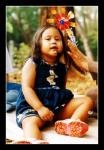In The Land Had The Forest, In Sea Had The Coral Reef
 The coral reef recorded the earth of history since hundreds of years set. When a coral reef was divided will express the age of the mainland nearby and at the same time as the sign note of nature that happened.
The coral reef recorded the earth of history since hundreds of years set. When a coral reef was divided will express the age of the mainland nearby and at the same time as the sign note of nature that happened.
Speedboat divided the wave in the Makassar Strait, recently. This machine boat carried a marine expert and Hasanuddin University fisheries in two researchers from the Centre of the Unhas Coral Reef Research and our team. This small party moved to the sideof the Samalona Island, around one hour of the water trip from the Makassar City, South Sulawesi.
Speedboat stopped in a point. To be precise in one of the coral reefs. The passengers descended by turns saw the condition for the coral reef in the explanation of the Samalona Island and observed results of rehabilitation of
model coral biorock. This rehabilitation activity was the co-operation between the Centre of the Unhas Coral Reef Research as well as the Marine Department and fisheries since six months set.
This diving the simile opened the window and gazed at the coral reef carpet. When in the land had the forest, in our sea will find the coral reef. The forest and the coral reef had the role that was same for the life of humankind and other living creatures. Moreover, the coral reef had the spectacular function: kept the history note of the life of the earth since hundreds set. Apart from that, the coral reef had the ecological function, economical but also aesthetics.
Ironically, the level of coral reef damage in the Motherland that had the area around 51.000 hectare reached 70 percent. The cause factor of damage was natural, the behaviour of humankind and global warming. Whether what will happen if not having rehabilitation. That was certain the earth no longer has the registrar of the history and pengingat the nature incident in the future.
Under the depth of blue sea stretched the style of the life that was shown through the plants dance and animals. Millions of wandering polyps fought to build coral. After becoming the colony, then was unfolded the reef like the forest in the mainland.
The story about rehabilitation of the coral reef was the story about the marine expert and fisheries as well as the coral reef researchers that finished many days in the middle of sea. The marine expert and the fisheries were Aidah A. A. Husain. Whereas the coral reef researcher was Halwi Temu and Amarullah Pious. The three of them became part of the Centre of the Unhas Coral Reef Research. They often carried out the research and rehabilitation of the coral reef in various places.
In the Explanation of the Samalona Island and Barrang Caddi, this team made the rehabilitation pilot project of the coral reef. They applied the model was different for rehabilitation of the coral reef that is biorock in Samalona and transplantation in Barrang Caddi. However with one aim: that is provoking the constructive polyp coral until becoming a colony.
Aidah explained, in fact living creatures that resided in coral were a living cell named the polyp. To be able to live the polyp depended on the other sea animal had a name zooxanthella that as though functioning as the rice warehouse. Polyp relations and zooxanthella or autotropik produced the process of photosynthesis and respiration. Whereas for protein supplies and the source of other energy was gotten from the process heterotropik through the plankton or the source nutrin other.
With the support zooxanthella and supplies nutrin that the polyp then had the strength to build the house that was acknowledged as coral. In the long run the corals became part of a dynamic ecosystem of coastal waters but were susceptible to the change in the environment named the coral reef.
The coral reef in Indonesia in the quite worrying condition. According to Aida, from around 50 thousand square metre the coral reef that was spread in various waters in the Motherland, Coremap and the Indonesian Science Agency recorded 70 percent including being broken heavy.
Not all the broken coral reefs could be rehabilitated. Especially for coral reef damage that happened in the explanation of the Samalona Island, the Centre of the Unhas Coral Reef Research and the Marine Department local drowned a framework of the iron had a name biorock since six months set.
The process of rehabilitation of the model biorock was the development from the research of Thomas J. Goreau and Wolf H. Hilbertz five years passed. His method by making the reef artificial from the iron that was formed like the igloo or the cone. The framework of the functioning iron as the cathode in the process elektrolisasi sea water. Whereas wires had the shape of the net to the anode.
To support the effect elektrolisasi, the cathode and this anode got electricity supplies as big as 12 volt from the cable that was connected to cell diesel fuel in the Samalona Island. The effect elektrolisasi that was expected to make calcium carbonate faster calcified. Six months beforehand, Halwi Temu and the other researcher installed one koralit coral that was cut off from a colony of coral and was tied to the iron carried this electricity cathode.
To support the effect elektrolisasi, the cathode and this anode got electricity supplies as big as 12 volt from the cable that was connected to cell diesel fuel in the Samalona Island. The effect elektrolisasi that was expected to make calcium carbonate faster calcified. Six months beforehand, Halwi Temu and the other researcher installed one koralit coral that was cut off from a colony of coral and was tied to the iron carried this electricity cathode.
Evidently efforts of the researchers showed moderate results pleasing. Six months after the period pembenaman biorock the igloo and attachments to coral, Aida recorded the long increase in coral in general happened one centimetre. According to him, the increase in the speed grew this was considered to be faster by five times from normal. This proved the effect elektrolisasi really could speed up the process of plastering.
The process of rehabilitation with the model biorock had the shape of the cone also showed positive results. Salt-water fish, although that was considered to be small, began to be cheerful playing inside. This carried hope for the fishermen. Aida added, the big benefit of coral will really be felt after corals scleractina this became a reef that also gave the ecological value and aesthetics as well as the function of the protection for the island nearby.
In the Barrang Caddi Island, the researchers did the transplantation model. This activity of the transplantation model was developed by the marine expert and Unhas fisheries were named Syafyudin Yusuf and the Consortium of the Beautiful Partner.
The Barrang Caddi island with the Barrang Lompo Island was the Spermonde Island that was known as the coral reef region with keanegaragaman quite high coral. Recorded was 78 genera and subgenera totally the species 262 kinds scleractini here.
The activity of the inhabitants was in this place considered to be high so as the threat of coral reef damage was then high. Was lucky to have a company of the coral cultivation that made this region the area of the protection of sea. This made the coral reef ecosystem in this region most protected. Moreover the inhabitants in the Barrang Caddi Island then were triggered took part in guarding, developing as well as gaining the economical value from a coral.
Antropogenic or prila I humankind that intentionally carried out the bombing or the anaesthetic with cyanide or mined directly coral that has been still becoming the threat of coral reef damage all over the Indonesian territory. Moreover, the illness threat and the predator in sea evidently took part in giving the contribution in coral reef damage. The fish kepe-kepe, the fish of cockatoo birds, the starfish as far as the pig hair was the example of the predators.
Apart from that had also the driller's organism that took part in the contribution reduced the colony of the coral reef. The most difficult threat was global warming that was caused the greenhouse that made the temperature of sea increase sharply apart from the safe limit the temperature for the coral reef between 18 and 28 Celsius levels. Results of the end of pengerusakan that was to be lost or the issuing zooxanthella actual was the rice warehouse for the polyp so as the polyp was hungry, became pale then turned pale or bleaching afterwards died.
In the Barrang Caddi Island, the researchers carried out rehabilitation of the transplantation model or the coral transplant with tied in a shelf in the seabed. His aim of restoring or forming the natural coral reef.
The process of rehabilitation of this transplantation model was preceeded by cutting off one koralit coral. After coral was stuck on one subtrat that was the cement mixture and the pumice. The substrate middle was made the hole to place pragmen coral. After that pembudi the coral power tied coral on an iron shelf.
According to the activist Coremap, that accompanied Aidah, the growth of coral cangkokan was enough to be seen. Most was not faster compared with coral that was allowed to live naturally. In sea be as deep as around five metre, Aidah and Ulla witnessed several iron shelves with the substrate containing coral that began memanjang. Five months in the future, these corals were marketed for the requirement for the aquarium decoration.
Aida, Ulla, and Halwi afterwards moved to the explanation ravine of the Barrang Caddi Island. In this place they did the grating or transek line to see the coral population in the certain distance.
The interesting note about the coral reef in this place was still many coral reefs with the diversity of the species that really spoiled the eyes. To the best of the eyes gaze at only was seen by algae colours that covered each kind of coral. Moreover fish decorated roamed about free as though taking part in enjoying beauty of the settlement region of this polyp.
From the growth of coral was the coral reef that and no longer became heaven for the sea biota and produced beauty of actual sea. However, the coral reef that increasingly firm will spread zonasi him so as he then became the patron of the available island behind.
Like the forest that became the supplier of biggest oxygen and the life lungs on the earth likewise with the coral reef for the life in sea. Increasingly turned pale the coral reef resulting from the hands of humankind, the predator or certain global warming brought the loss that very much really. Because the impact finally also will be felt to humankind that not only lost the source of the ecology, economics and aesthetics, but the patron of the life in the mainland took part in vanishing.
More than that, humankind will lose the wealth nan was not considered. Namely the registrar of the history of the earth trip. Because evidently when a coral reef was divided then will express the age of the mainland nearby at the same time the note of the nature incident that had happened. Then really ran at a loss when the patron and the registrar of the history of the life of this earth were destroyed. (Budi Iswara/tna)





